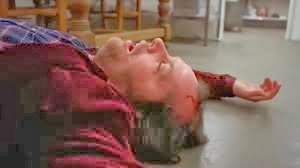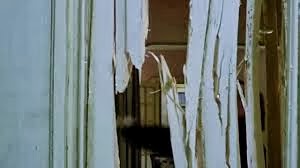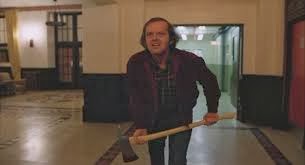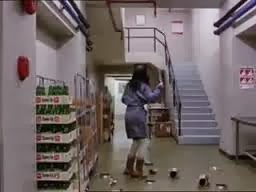Jack Torrance: Heeere's Johnny!
A family heads to an isolated hotel for the winter where an evil and spiritual presence influences the father into violence, while his psychic son sees horrific forebodings from the past and of the future.
Based on the book written by Stephen King, it was on the 23rd of May, 1980 that "The Shining" would make its premiere in the US. Four months later it would premiere in countries such as Denmark, Finland, Norway and Sweden before appearing on screens in various other countries. However, for whatever reason, it was not shown in theaters in the UK.
With an estimated $19 million in its budget, "The Shining" earned over $44 million at the Box Office in 1980, making it the highest grossing horror film that year. It wasn't nominated for any Academy Awards or Golden Globes, but it was, however, nominated for two Razzies (an award one does not want to be nominated for when in the film business): Worst Actress for Shelley Duvall (I have to agree with that) and Stanley Kubrick received the nomination for Worst Director (I don't agree with that decision at all).
"The Shining" was directed by legendary Stanley Kubrck. A couple of reasons why Kubrick and this film was such a good pairing was because he understood psychology and knew how to manipulate his cast. He did this with both Shelley Duvall as well with Scatman Crothers in which he had the actor do 148 takes in the scene where he and Danny Lloyd discuss shining in the kitchen (this still stands as a world record, by the way). But Stanley had a heart, too. He was very protective of Danny Lloyd who was very young during filming ("The Shining" was his first and only feature film) and didn't want Danny to know the film was horror in its style. "It's a drama," he told him. In fact, Stanley was insistent on this that in the scene where "Wendy" is yelling at "Jack," she's actually holding a life-size doll of Danny, not Danny himself. I'll add that Danny didn't see "The Shining" until many years later. He was 17 at the time, eleven years after he'd made the film. Stanley Kubrick didn't see the film at all as it was his custom to never watch the films he directed.
The main cast for "The Shining" included Jack Nicholson as Jack, Shelley Duvall as Wendy, Danny Lloyd as Danny, Scatman Crothers as Dick, Barry Nelson as Stuart, Philip Stone as Delbert Grady, and Joe Turkel as Joe the Bartender.
Filmed in locations such as Colorado, Glacier National Park in Montana, the Timberline Lodge in Mt. Hood, Oregon (exterior shot), Yosemite National Park in California, and at the Elstree Studios in Borehamwood, Hertfordshire, England, here are some more bits of information regarding "The Shining" you might not have known...
1. Stephen King was first approached by Stanley Kubrick about making a film version of 'The Shining' via an early morning phone call (England is five hours ahead of Maine in time zones). King, suffering from a hangover, shaving and at first thinking one of his kids was injured, was shocked when his wife told him Kubrick was really on the phone. King recalled that the first thing Kubrick did was to immediately start talking about how optimistic ghost stories are, because they suggest that humans survive death. "What about hell?" King asked. Kubrick paused for several moments before finally replying, "I don't believe in hell."
2. Prior to hiring Diane Johnson as his writing partner, director/producer Stanley Kubrick rejected a screenplay written by Stephen King himself. King's script was a much more literal adaptation of the novel, a much more traditional horror film than the film Kubrick would ultimately make. He was considering hiring Johnson because he admired her novel "The Shadow Knows," but when he found out she was a Doctor of Gothic Studies, he became convinced she was the person for the job.
3. Stanley Kubrick considered both Robert De Niro and Robin Williams for the role of Jack Torrance but decided against both of them. Kubrick didn't think De Niro would suit the part after watching his performance in "Taxi Driver", as he deemed De Niro not psychotic enough for the role. He didn't think Williams would suit the part after watching his performance in TV's "Mork & Mindy", as he deemed him too psychotic for the role. According to Stephen King, Kubrick also briefly considered Harrison Ford.
4. Stephen King tried to talk Stanley Kubrick out of casting Jack Nicholson in the lead suggesting, instead, either Michael Moriarty or Jon Voight. King had felt that watching either of these normal-looking men gradually descend into madness, would have immensely improved the dramatic thrust of the storyline.
5. Stanley Kubrick had envisioned Shelley Duvall as his more timid, dependent version of Wendy Torrance from the very beginning. However Jack Nicholson after reading the novel, wanted Jessica Lange for the part of Wendy, and even recommended her to Kubrick, as he felt she fit Stephen King's version of the character. After explaining the changes he had made, Kubrick convinced him that Duvall was the correct choice, as she best suited the emotionally fragile Wendy he had in mind. Many years later, Nicholson told EMPIRE magazine he thought Duvall was fantastic and called her work in the film, "the toughest job that any actor that I've seen had."
6. Stanley Kubrick's first choice to play Danny Torrance was Cary Guffey, the young boy from "Close Encounters of the Third Kind". Guffey's parents apparently turned down the offer due to the film's subject matter.
7. Scatman Crothers was a friend of Jack Nicholson's, and when he heard about the Halloran role, he asked Nicholson to talk to Stanley Kubrick about casting him.
8. The role of Lloyd the Bartender was originally to have been played by Harry Dean Stanton, who was unable to take the part due to his commitment to the film "Alien".
9. Stanley Kubrick wanted to shoot the film in script order. This meant having all the relevant sets standing by at all times. In order to achieve this, every soundstage at Elstree was used, with all the sets built, pre-lit and ready to go during the entire shoot at the studios.
10. The famous opening scene was shot in Glacier National Park in Montana just north of St. Mary's Lake. The road seen in the scene, Going-to-the-Sun Road, does actually close down during winter and is only negotiable by snowcat. Kubrick initially sent a second unit to the Rockies in Colorado, but they reported back that the area wasn't very interesting. When Stanley Kubrick saw the footage they had shot, he was furious, and fired the entire unit. He then sent Greg MacGillivray, a noted helicopter cameraman, to Montana and it was McGillivray who shot the scene.
11. During filming, Stanley Kubrick made the cast watch "Eraserhead", "Rosemary's Baby" and "The Exorcist" to put them in the right frame of mind.
12. The color red is visible, either overtly or subtly, in nearly every shot of the film. (Makes one wonder if M. Night Shyamalan took that idea for his film "The Sixth Sense".)
13. The idea for Danny Lloyd to move his finger when he was talking as Tony was his own. He did it spontaneously during his very first audition.
14. To construct the interiors of the Overlook, Stanley Kubrick and his production designer, Roy Walker purposely set out to make it look like an amalgamation of bits and pieces of real hotels, rather than giving it one single design ethic. Kubrick had sent many photographers around the country photographing hotel rooms and picking his favorite. For example, the red men's bathroom was modeled on a men's room in the Biltmore Hotel in Arizona designed by Frank Lloyd Wright, and the Colorado lounge was modeled on the lounge of the Ahwanee Hotel in the Yosemite Valley. Indeed, the chandeliers, windows and fireplace are nearly identical, so much so that people entering the Ahwahnee often ask if it's "the Shining hotel".
15. During the scene where Wendy brings Jack breakfast in bed, it can be seen in the reflection of the mirror that Jack's T-shirt says "Stovington" on it. While not mentioned in the film, this is the name of the school that Jack used to teach at in the Stephen King novel.
16. For the scenes when we can hear Jack typing but we cannot see what he is typing, Stanley Kubrick recorded the sound of a typist actually typing the words "All work and no play makes Jack a dull boy". Some people argue that each key on a typewriter sounds slightly different, and Kubrick wanted to ensure authenticity, so he insisted that the actual words be typed.
17. Steadicam operator Garrett Brown accomplished many of the ultra-low tracking corridor sequences from a wheelchair on which his invention was mounted. Grips would either pull backward or push forward the wheelchair, depending on the requirement of the shot
18. The only shot in the film not achieved in-camera was the slow zoom in on the model of the maze, with the tiny figures of Danny and Wendy walking around at the center. To achieve this shot, a model of the maze was shot from six feet above. Then the small central section of the maze was built to scale next to an apartment complex. Actors Shelley Duvall and Danny Lloyd then walked about in the central section whilst the camera crew filmed it from the roof of the apartment building. The two shots were then simply composited together.
19. There was no air conditioning on the sets, meaning it would often become very hot. The hedge maze set was stifling; actors and crew would often strip off as much of the heavy clothing they were wearing as quickly as they could once a shot was finished.
20. The maze was constructed on an airfield near Elstree studios, by weaving branches to chicken wire mounted on empty plywood boxes. The maze was shot using an extremely short lens (a 9.8mm, which gives a horizontal viewing angle of 90 degrees) which was kept dead level at all times, to make the hedges seem much bigger and more imposing than they were in reality.
21. In the party scene, Stanley Kubrick told the extras to mouth their words.
22. The throwing around of the tennis ball inside the overlook hotel was Jack Nicholson's idea. The script originally only specified that, "Jack is not working".
23. The shot of the tennis ball rolling into Danny's toys took 50 takes to get right.
24. The script was constantly changing on set, sometimes several times a day. The cast got very irritated by this, especially Jack Nicholson. Whenever the production team would give the cast copies of the script to memorize, Jack Nicholson would throw his away without even looking at it, as he knew that it was only going to change again.
25. Anjelica Huston lived with Jack Nicholson during the time of the shooting. She recalled that, due to the long hours on the set and Stanley Kubrick's trademark style of repetitive takes, Nicholson would often return from a day's shooting, walk straight to the bed, collapse onto it and would immediately fall asleep.
26. Jack tells Lloyd in the bar that Danny once messed around with his work papers. This mirrors an event in Stephen King's life, when his son once started playing around with his writing notes. He felt like killing him.
27. Neither Lia Beldam (young woman in bath) nor Billie Gibson (old woman in bath) appeared in another movie before or after this one.
28. Stanley Kubrick, known for his compulsiveness and numerous retakes, got the difficult shot of blood pouring from the elevators in only three takes. This would be remarkable if it weren't for the fact that the shot took nine days to set up; every time the doors opened and the blood poured out, Kubrick would say, "It doesn't look like blood." In the end, the shot took approximately a year to get right.
29. The scene of Hallorann approaching the hotel in the snow-cat was shot in real snow approaching the real Timberline hotel in Oregon.
30. The scene towards the end of the film, where Wendy is running up the stairway carrying a knife, was shot 35 times; the equivalent of running up the Empire State Building.
31. Jack Nicholson ad-libbed the "little pigs" dialog towards the end of the film.
32. For the scene in which Jack breaks down the bathroom door, the props department built a door that could be easily broken. However, Jack Nicholson had worked as a volunteer fire marshal and tore it apart far too easily. The props department were then forced to build a stronger door. According to Shelley Duvall the infamous 'Heere's Johnny!' scene took 3 days to film and the use of 60 doors.
33. The line "Heeere's Johnny!" was an ad-lib by Jack Nicholson and not part of the script at all. Stanley Kubrick liked it and kept it in the film. It would become one of the most memorable moments not just for the film itself, but for the history of horror films altogether.
34. The "snowy" maze near the conclusion of the movie consisted of 900 tons of salt and crushed Styrofoam.
35. The 1921 photograph at the end of the film was a genuine 1920s photo, with Jack Nicholson's head airbrushed onto the body of another man. Stanley Kubrick originally planned to use extras and shoot the photo himself, but he realized he couldn't make it look any better than the real thing.
36. The film was released on Scatman Crother's 70th birthday.
37. On the DVD commentary track for "Making 'The Shining'", Vivian Kubrick reveals that Shelley Duvall received "no sympathy at all" from anyone on the set. This was apparently Stanley Kubrick's tactic in making her feel utterly hopeless. This is most evident in the documentary when he tells Vivian, "Don't sympathize with Shelley." Kubrick then goes on to tell Duvall, "It doesn't help you."
38. Despite Stanley Kubrick's fierce demands on everyone, Jack Nicholson admitted to having a good working relationship with him. It was with Shelley Duvall that he was a completely different director. He allegedly picked on her more than anyone else, as seen in the documentaries Making "The Shining" and "Stanley Kubrick: A Life in Pictures". He would really lose his temper with her, even going so far as to say that she was wasting the time of everyone on the set. She later reflected that he was probably pushing her to her limits to get the best out of her, and that she wouldn't trade the experience for anything - but it was not something she ever wished to repeat.
39. During an interview, Shelley Duvall revealed that due to her role requiring her to be in an almost constant state of hysteria, she eventually ran out of tears from crying so hard. To overcome this she kept bottles of water with her at all times on set to remain hydrated.
40. According to Variety magazine, the film took almost 200 days to shoot. However, according to assistant editor Gordon Stainforth, it took much more, nearly a year. The film was originally supposed to take 17 weeks, but it ultimately took 51. Because the film ran so long, Warren Beatty's "Reds" and Steven Spielberg's "Raiders of the Lost Ark" were both delayed as they were both waiting to shoot in Elstree Studios.
41. When Steadicam inventor/operator Garrett Brown was hired to work on the picture, he was assured that there was no way the shoot would run over six months, as he had to be back in the US in six months time to shoot "Rocky II". Six months into the shoot, less than half the film had been shot, and for several months, Brown worked one week in London on "The Shining," one week in Philadelphia on "Rocky II," commuting by Concorde every Sunday.
42. It turned out that Stephen King was quite disappointed in the final film. While admitting that Stanley Kubrick's visuals were stunning, he said that was surface and not substance. He often described the film as "a fancy car without an engine."
And now you know.
There is a great deal of confusion regarding this film and the number of retakes of certain scenes. According to the Guinness Book of Records, the scene where Wendy is backing up the stairs swinging the baseball bat was shot 127 times, which is a record for the most takes of a single scene. However, both Steadicam operator Garrett Brown and assistant editor Gordon Stainforth say this is inaccurate - the scene was shot about 35-45 times.
Please enjoy the following preview to "The Shining" as well as picture stills from the film...
Now the main characters...
Here are over 200 pictures stills of the film laid out in chronological order...




And now some pictures of what took place on the set of the film...




Wendy Torrance: [crying] Stay away from me.
Jack Torrance: Why? Wendy Torrance: I just wanna go back to my room!
Jack Torrance: Why?
Wendy Torrance: Well, I'm very confused, and I just need time to think things over!
Jack Torrance: You've had your whole FUCKING LIFE to think things over, what good's a few minutes more gonna do you now?
Wendy Torrance: Please! Don't hurt me!
Jack Torrance: I'm not gonna hurt you.
Wendy Torrance: Stay away from me!
Jack Torrance: Wendy? Darling? Light, of my life. I'm not gonna hurt ya. You didn't let me finish my sentence. I said, I'm not gonna hurt ya. I'm just going to bash your brains in.
[Wendy gasps]
Jack Torrance: Gonna bash 'em right the fuck in! ha ha ha
Wendy Torrance: Stay away from me! Don't hurt me!
Jack Torrance: [sarcastically] I'm not gonna hurt ya...
Wendy Torrance: Stay away! Stop it!
Jack Torrance: Stop swingin' the bat. Put the bat down, Wendy. Wendy? Give me the bat...




































































































































































































































No comments:
Post a Comment